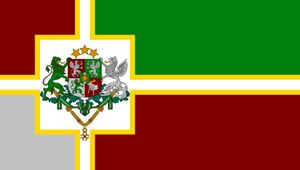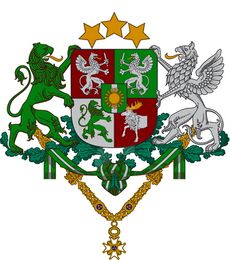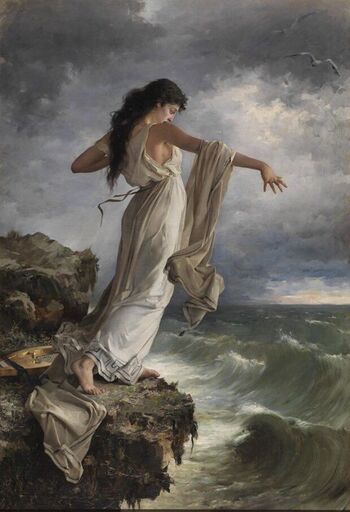National symbols of Eastarland: Difference between revisions
Jump to navigation
Jump to search
(Created page with "{| width=85% class="wikitable" ! width=12% | Name ! width=13% | Symbol ! width=75% | Description |- |align="center"|{{wp|Royal flag}} |align="center"|File:Ee22.jpg|350 px|le...") |
No edit summary |
||
| (10 intermediate revisions by the same user not shown) | |||
| Line 5: | Line 5: | ||
|- | |- | ||
|align="center"|{{wp|Royal flag}} | |align="center"|{{wp|Royal flag}} | ||
|align="center"|[[File: | |align="center"|[[File:Empire 's banner.jpg|300 px|frameless]] | ||
|align="center"|The Royal Flag of the | |align="center"|The Royal Flag of the Empire of Eastarland is the first symbol of statehood, enshrined in a state act dated November 3, 1804. Later, in May 1855, the exact description of the main symbol of statehood was confirmed in the Constitution (Satversme) of the Empire of Eastarland: | ||
<br> | <br> | ||
|- | |- | ||
|align="center"|{{wp|Coat of arms}} | |align="center"|{{wp|Coat of arms}} | ||
|align="center"|[[File: | |align="center"|[[File:Coa of Empire.jpg|230 px|frameless]] | ||
|align="center"|The state royal coat of arms of the | |align="center"|The state royal coat of arms of the Empire of Eastarland is the second state symbol, from 1712 to 1804 it was the state symbol of the Principality of Baltesia and the Farenburg-Meiss-Orin dynasty, which ruled there. At the Council of Ministers in April 1805, the coat of arms of the entire Empire was chosen. | ||
<br> | <br> | ||
|- | |- | ||
|align="center"|{{wp|National anthem}} | |||
|align="center"|[[File:Eastarland Anthem.png|200px]] [[File:MediaPlayer.png|link=https://www.youtube.com/watch?v=_bk5iZViZgc|thumb|upright=0.65|center|''Gloria aeterna!'']] | |||
|align="center"|The national anthem is "Gloria aeterna!" ("Eternal Glory!"). The text was written in 1817 by the poet Ingars Ezergailis, the music was written by the composer Heleri Aare in 1818. In 1821 it became the official anthem. | |||
|- | |||
|align="center"|{{wp|National personification}} | |||
|align="center"|[[File:Trōndina.jpg|350px]] | |||
|align="center"|[[Livuria]] or Livurie (Letian: Livurija; pronounced: [livu'ria:] - the national personification of the Empire of Eastarland, represented during the war of the Livurian Coalition against the Terany of the Castarilian Empire, as the personification of war, self-determination and freedom, and the image of the Goddess of Liberty and the Goddess of War. Livuria is printed on banknotes, engraved on coins, depicted on postage stamps, and sometimes on government documents. Trоndina is one of the brightest symbols of Eastarland. | |||
<br>Livuria is the protector of Eastarland and all Livurians. | |||
<br>In times of peace, she helps to achieve prosperity, favors farmers and workers, scientists and architects, poets and musicians. She helps those who have gone astray, takes ships away from dangerous reefs and rocks, leading them to the port. | |||
<br>During the war, she leads the troops to victory on the battlefield, crushing enemies, and weeps for the killed soldiers. | |||
|- | |||
|} | |||
Latest revision as of 19:57, 1 May 2021
| Name | Symbol | Description |
|---|---|---|
| Royal flag | 
|
The Royal Flag of the Empire of Eastarland is the first symbol of statehood, enshrined in a state act dated November 3, 1804. Later, in May 1855, the exact description of the main symbol of statehood was confirmed in the Constitution (Satversme) of the Empire of Eastarland:
|
| Coat of arms | 
|
The state royal coat of arms of the Empire of Eastarland is the second state symbol, from 1712 to 1804 it was the state symbol of the Principality of Baltesia and the Farenburg-Meiss-Orin dynasty, which ruled there. At the Council of Ministers in April 1805, the coat of arms of the entire Empire was chosen.
|
| National anthem | 
|
The national anthem is "Gloria aeterna!" ("Eternal Glory!"). The text was written in 1817 by the poet Ingars Ezergailis, the music was written by the composer Heleri Aare in 1818. In 1821 it became the official anthem. |
| National personification | 
|
Livuria or Livurie (Letian: Livurija; pronounced: [livu'ria:] - the national personification of the Empire of Eastarland, represented during the war of the Livurian Coalition against the Terany of the Castarilian Empire, as the personification of war, self-determination and freedom, and the image of the Goddess of Liberty and the Goddess of War. Livuria is printed on banknotes, engraved on coins, depicted on postage stamps, and sometimes on government documents. Trоndina is one of the brightest symbols of Eastarland.
|